Nursing: Adverse Events, Risk Assessment, and Patient Safety
VerifiedAdded on 2022/10/17
|7
|1649
|16
Report
AI Summary
This report provides a comprehensive analysis of adverse events, such as falls, pressure ulcers, and malnutrition, in nursing home settings. It addresses the PICO question: 'Does risk assessment influence the rate of adverse events among nursing home residents compared with no risk assessment?' The report reviews a relevant research study by Lannering et al. (2016), which highlights the importance of mobility and activity factors in risk assessment. It evaluates the study's reliability and validity, identifying strengths like the use of regression analysis and a 12-month follow-up, and weaknesses such as low internal consistency of the research tools and the use of convenience sampling. The report also examines the clinical guidelines from the South Australian Government and a systematic review of systematic reviews, finding interventions to prevent adverse events. The conclusion emphasizes the importance of prioritizing mobility assessment and selecting tools with high internal consistency to improve patient safety and reduce adverse events. The report also includes relevant references to support the findings.
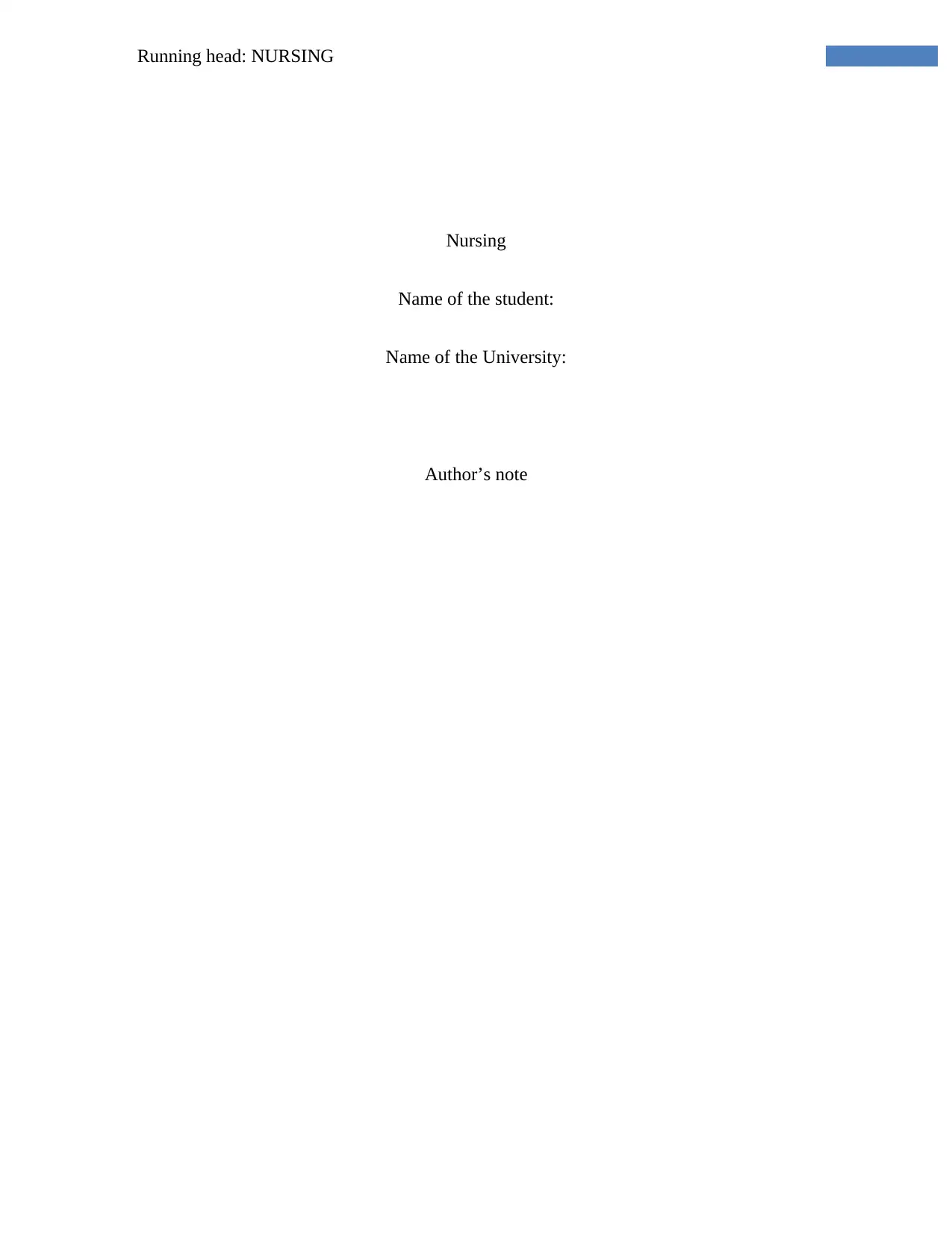
Running head: NURSING
Nursing
Name of the student:
Name of the University:
Author’s note
Nursing
Name of the student:
Name of the University:
Author’s note
Paraphrase This Document
Need a fresh take? Get an instant paraphrase of this document with our AI Paraphraser
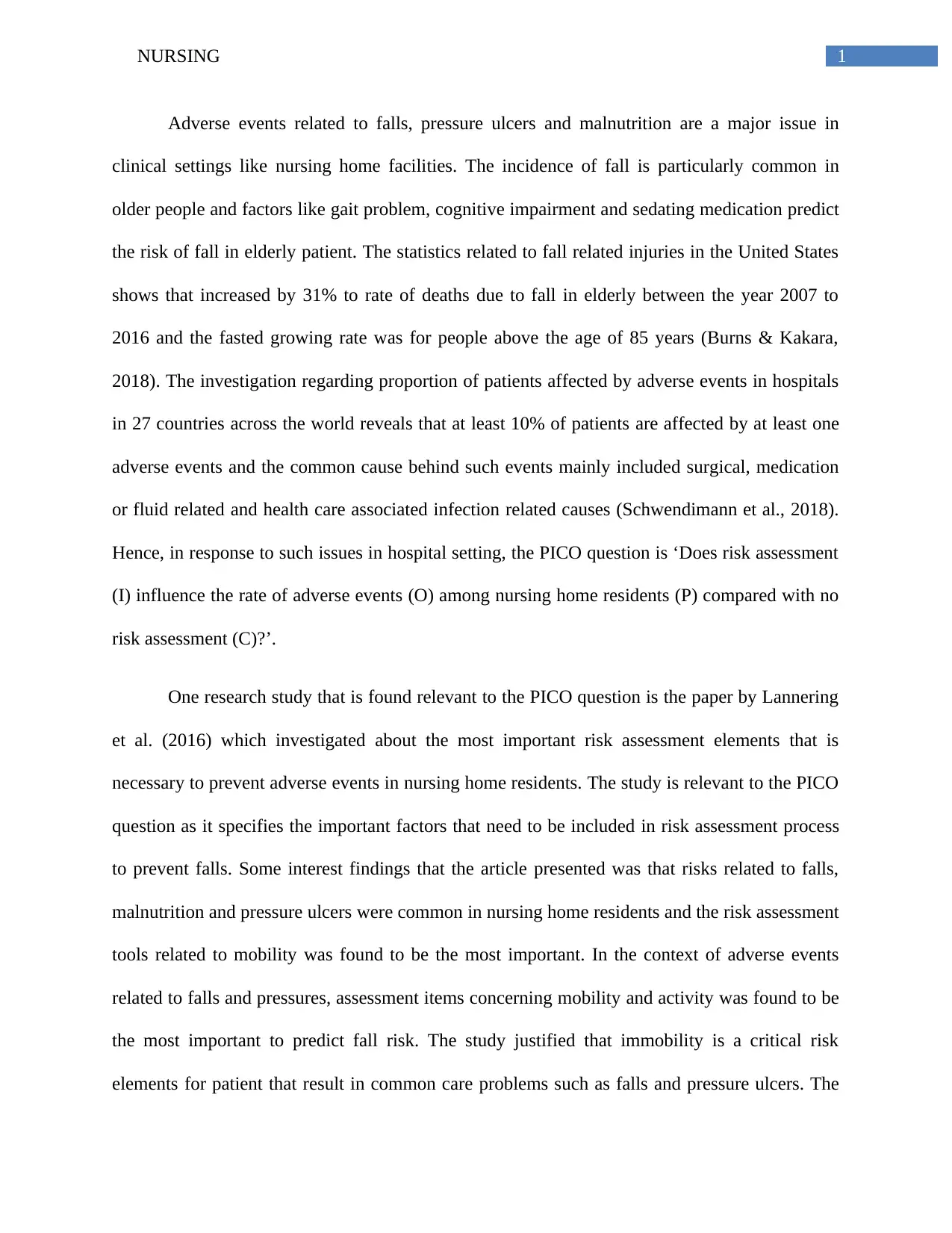
1NURSING
Adverse events related to falls, pressure ulcers and malnutrition are a major issue in
clinical settings like nursing home facilities. The incidence of fall is particularly common in
older people and factors like gait problem, cognitive impairment and sedating medication predict
the risk of fall in elderly patient. The statistics related to fall related injuries in the United States
shows that increased by 31% to rate of deaths due to fall in elderly between the year 2007 to
2016 and the fasted growing rate was for people above the age of 85 years (Burns & Kakara,
2018). The investigation regarding proportion of patients affected by adverse events in hospitals
in 27 countries across the world reveals that at least 10% of patients are affected by at least one
adverse events and the common cause behind such events mainly included surgical, medication
or fluid related and health care associated infection related causes (Schwendimann et al., 2018).
Hence, in response to such issues in hospital setting, the PICO question is ‘Does risk assessment
(I) influence the rate of adverse events (O) among nursing home residents (P) compared with no
risk assessment (C)?’.
One research study that is found relevant to the PICO question is the paper by Lannering
et al. (2016) which investigated about the most important risk assessment elements that is
necessary to prevent adverse events in nursing home residents. The study is relevant to the PICO
question as it specifies the important factors that need to be included in risk assessment process
to prevent falls. Some interest findings that the article presented was that risks related to falls,
malnutrition and pressure ulcers were common in nursing home residents and the risk assessment
tools related to mobility was found to be the most important. In the context of adverse events
related to falls and pressures, assessment items concerning mobility and activity was found to be
the most important to predict fall risk. The study justified that immobility is a critical risk
elements for patient that result in common care problems such as falls and pressure ulcers. The
Adverse events related to falls, pressure ulcers and malnutrition are a major issue in
clinical settings like nursing home facilities. The incidence of fall is particularly common in
older people and factors like gait problem, cognitive impairment and sedating medication predict
the risk of fall in elderly patient. The statistics related to fall related injuries in the United States
shows that increased by 31% to rate of deaths due to fall in elderly between the year 2007 to
2016 and the fasted growing rate was for people above the age of 85 years (Burns & Kakara,
2018). The investigation regarding proportion of patients affected by adverse events in hospitals
in 27 countries across the world reveals that at least 10% of patients are affected by at least one
adverse events and the common cause behind such events mainly included surgical, medication
or fluid related and health care associated infection related causes (Schwendimann et al., 2018).
Hence, in response to such issues in hospital setting, the PICO question is ‘Does risk assessment
(I) influence the rate of adverse events (O) among nursing home residents (P) compared with no
risk assessment (C)?’.
One research study that is found relevant to the PICO question is the paper by Lannering
et al. (2016) which investigated about the most important risk assessment elements that is
necessary to prevent adverse events in nursing home residents. The study is relevant to the PICO
question as it specifies the important factors that need to be included in risk assessment process
to prevent falls. Some interest findings that the article presented was that risks related to falls,
malnutrition and pressure ulcers were common in nursing home residents and the risk assessment
tools related to mobility was found to be the most important. In the context of adverse events
related to falls and pressures, assessment items concerning mobility and activity was found to be
the most important to predict fall risk. The study justified that immobility is a critical risk
elements for patient that result in common care problems such as falls and pressure ulcers. The
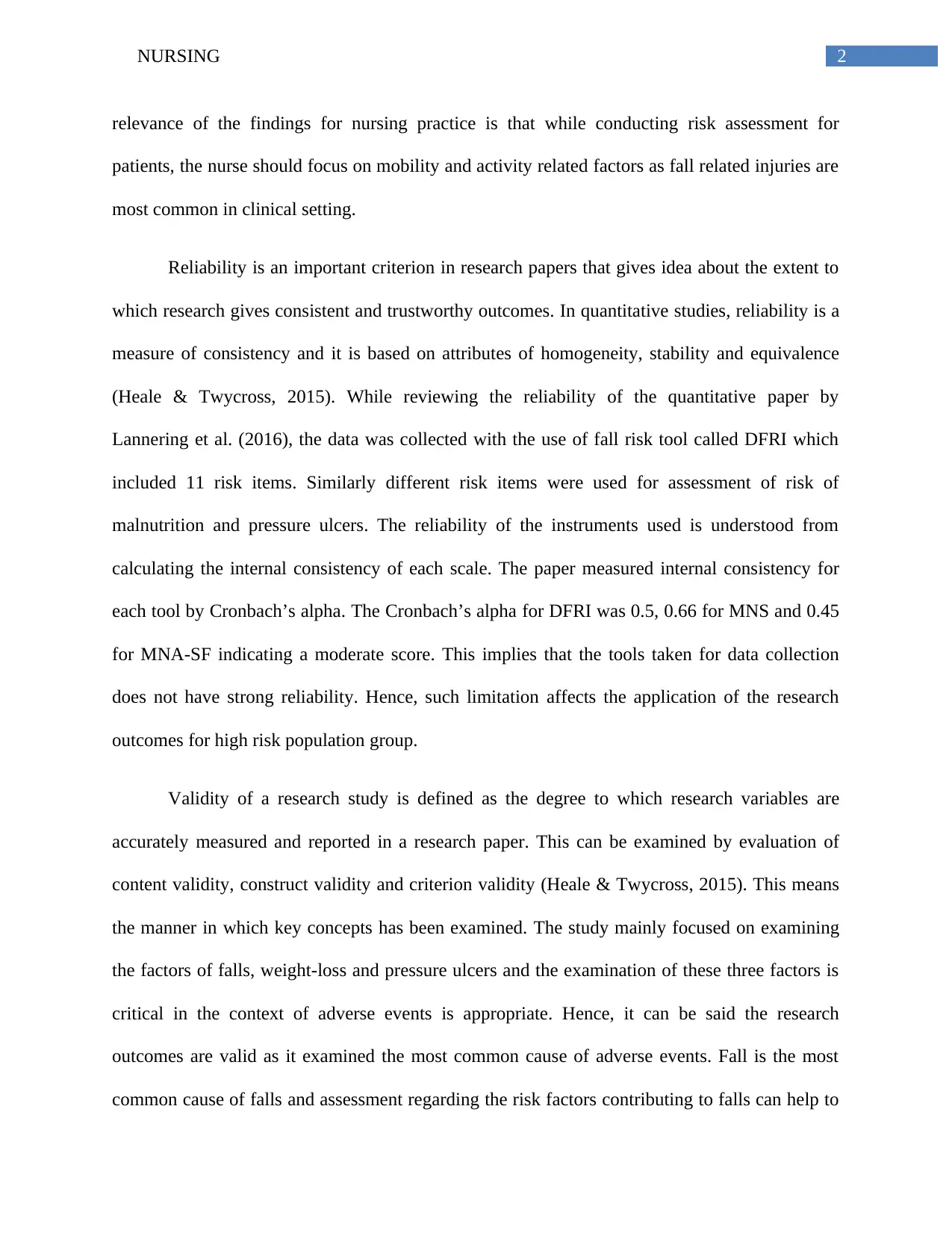
2NURSING
relevance of the findings for nursing practice is that while conducting risk assessment for
patients, the nurse should focus on mobility and activity related factors as fall related injuries are
most common in clinical setting.
Reliability is an important criterion in research papers that gives idea about the extent to
which research gives consistent and trustworthy outcomes. In quantitative studies, reliability is a
measure of consistency and it is based on attributes of homogeneity, stability and equivalence
(Heale & Twycross, 2015). While reviewing the reliability of the quantitative paper by
Lannering et al. (2016), the data was collected with the use of fall risk tool called DFRI which
included 11 risk items. Similarly different risk items were used for assessment of risk of
malnutrition and pressure ulcers. The reliability of the instruments used is understood from
calculating the internal consistency of each scale. The paper measured internal consistency for
each tool by Cronbach’s alpha. The Cronbach’s alpha for DFRI was 0.5, 0.66 for MNS and 0.45
for MNA-SF indicating a moderate score. This implies that the tools taken for data collection
does not have strong reliability. Hence, such limitation affects the application of the research
outcomes for high risk population group.
Validity of a research study is defined as the degree to which research variables are
accurately measured and reported in a research paper. This can be examined by evaluation of
content validity, construct validity and criterion validity (Heale & Twycross, 2015). This means
the manner in which key concepts has been examined. The study mainly focused on examining
the factors of falls, weight-loss and pressure ulcers and the examination of these three factors is
critical in the context of adverse events is appropriate. Hence, it can be said the research
outcomes are valid as it examined the most common cause of adverse events. Fall is the most
common cause of falls and assessment regarding the risk factors contributing to falls can help to
relevance of the findings for nursing practice is that while conducting risk assessment for
patients, the nurse should focus on mobility and activity related factors as fall related injuries are
most common in clinical setting.
Reliability is an important criterion in research papers that gives idea about the extent to
which research gives consistent and trustworthy outcomes. In quantitative studies, reliability is a
measure of consistency and it is based on attributes of homogeneity, stability and equivalence
(Heale & Twycross, 2015). While reviewing the reliability of the quantitative paper by
Lannering et al. (2016), the data was collected with the use of fall risk tool called DFRI which
included 11 risk items. Similarly different risk items were used for assessment of risk of
malnutrition and pressure ulcers. The reliability of the instruments used is understood from
calculating the internal consistency of each scale. The paper measured internal consistency for
each tool by Cronbach’s alpha. The Cronbach’s alpha for DFRI was 0.5, 0.66 for MNS and 0.45
for MNA-SF indicating a moderate score. This implies that the tools taken for data collection
does not have strong reliability. Hence, such limitation affects the application of the research
outcomes for high risk population group.
Validity of a research study is defined as the degree to which research variables are
accurately measured and reported in a research paper. This can be examined by evaluation of
content validity, construct validity and criterion validity (Heale & Twycross, 2015). This means
the manner in which key concepts has been examined. The study mainly focused on examining
the factors of falls, weight-loss and pressure ulcers and the examination of these three factors is
critical in the context of adverse events is appropriate. Hence, it can be said the research
outcomes are valid as it examined the most common cause of adverse events. Fall is the most
common cause of falls and assessment regarding the risk factors contributing to falls can help to
⊘ This is a preview!⊘
Do you want full access?
Subscribe today to unlock all pages.

Trusted by 1+ million students worldwide
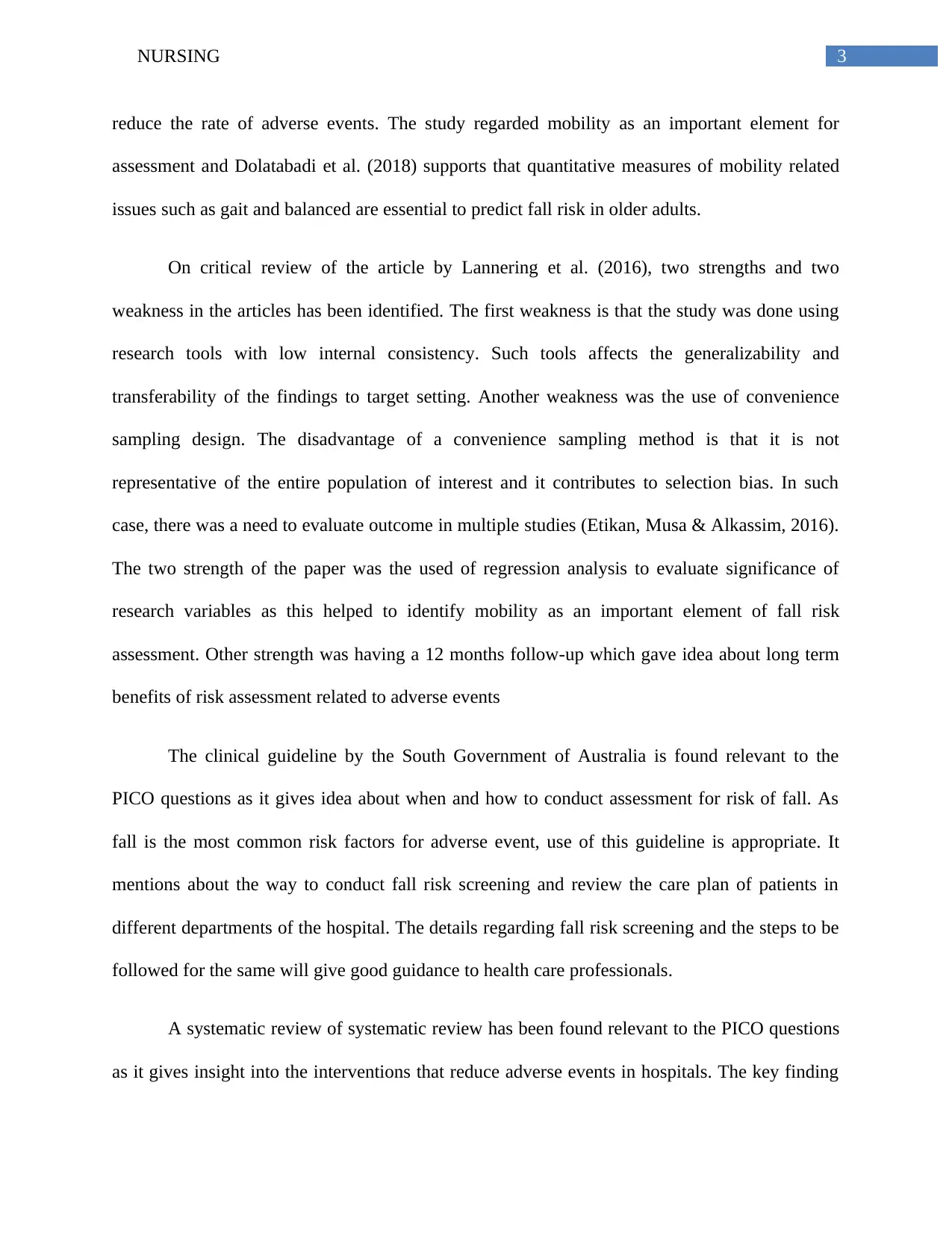
3NURSING
reduce the rate of adverse events. The study regarded mobility as an important element for
assessment and Dolatabadi et al. (2018) supports that quantitative measures of mobility related
issues such as gait and balanced are essential to predict fall risk in older adults.
On critical review of the article by Lannering et al. (2016), two strengths and two
weakness in the articles has been identified. The first weakness is that the study was done using
research tools with low internal consistency. Such tools affects the generalizability and
transferability of the findings to target setting. Another weakness was the use of convenience
sampling design. The disadvantage of a convenience sampling method is that it is not
representative of the entire population of interest and it contributes to selection bias. In such
case, there was a need to evaluate outcome in multiple studies (Etikan, Musa & Alkassim, 2016).
The two strength of the paper was the used of regression analysis to evaluate significance of
research variables as this helped to identify mobility as an important element of fall risk
assessment. Other strength was having a 12 months follow-up which gave idea about long term
benefits of risk assessment related to adverse events
The clinical guideline by the South Government of Australia is found relevant to the
PICO questions as it gives idea about when and how to conduct assessment for risk of fall. As
fall is the most common risk factors for adverse event, use of this guideline is appropriate. It
mentions about the way to conduct fall risk screening and review the care plan of patients in
different departments of the hospital. The details regarding fall risk screening and the steps to be
followed for the same will give good guidance to health care professionals.
A systematic review of systematic review has been found relevant to the PICO questions
as it gives insight into the interventions that reduce adverse events in hospitals. The key finding
reduce the rate of adverse events. The study regarded mobility as an important element for
assessment and Dolatabadi et al. (2018) supports that quantitative measures of mobility related
issues such as gait and balanced are essential to predict fall risk in older adults.
On critical review of the article by Lannering et al. (2016), two strengths and two
weakness in the articles has been identified. The first weakness is that the study was done using
research tools with low internal consistency. Such tools affects the generalizability and
transferability of the findings to target setting. Another weakness was the use of convenience
sampling design. The disadvantage of a convenience sampling method is that it is not
representative of the entire population of interest and it contributes to selection bias. In such
case, there was a need to evaluate outcome in multiple studies (Etikan, Musa & Alkassim, 2016).
The two strength of the paper was the used of regression analysis to evaluate significance of
research variables as this helped to identify mobility as an important element of fall risk
assessment. Other strength was having a 12 months follow-up which gave idea about long term
benefits of risk assessment related to adverse events
The clinical guideline by the South Government of Australia is found relevant to the
PICO questions as it gives idea about when and how to conduct assessment for risk of fall. As
fall is the most common risk factors for adverse event, use of this guideline is appropriate. It
mentions about the way to conduct fall risk screening and review the care plan of patients in
different departments of the hospital. The details regarding fall risk screening and the steps to be
followed for the same will give good guidance to health care professionals.
A systematic review of systematic review has been found relevant to the PICO questions
as it gives insight into the interventions that reduce adverse events in hospitals. The key finding
Paraphrase This Document
Need a fresh take? Get an instant paraphrase of this document with our AI Paraphraser
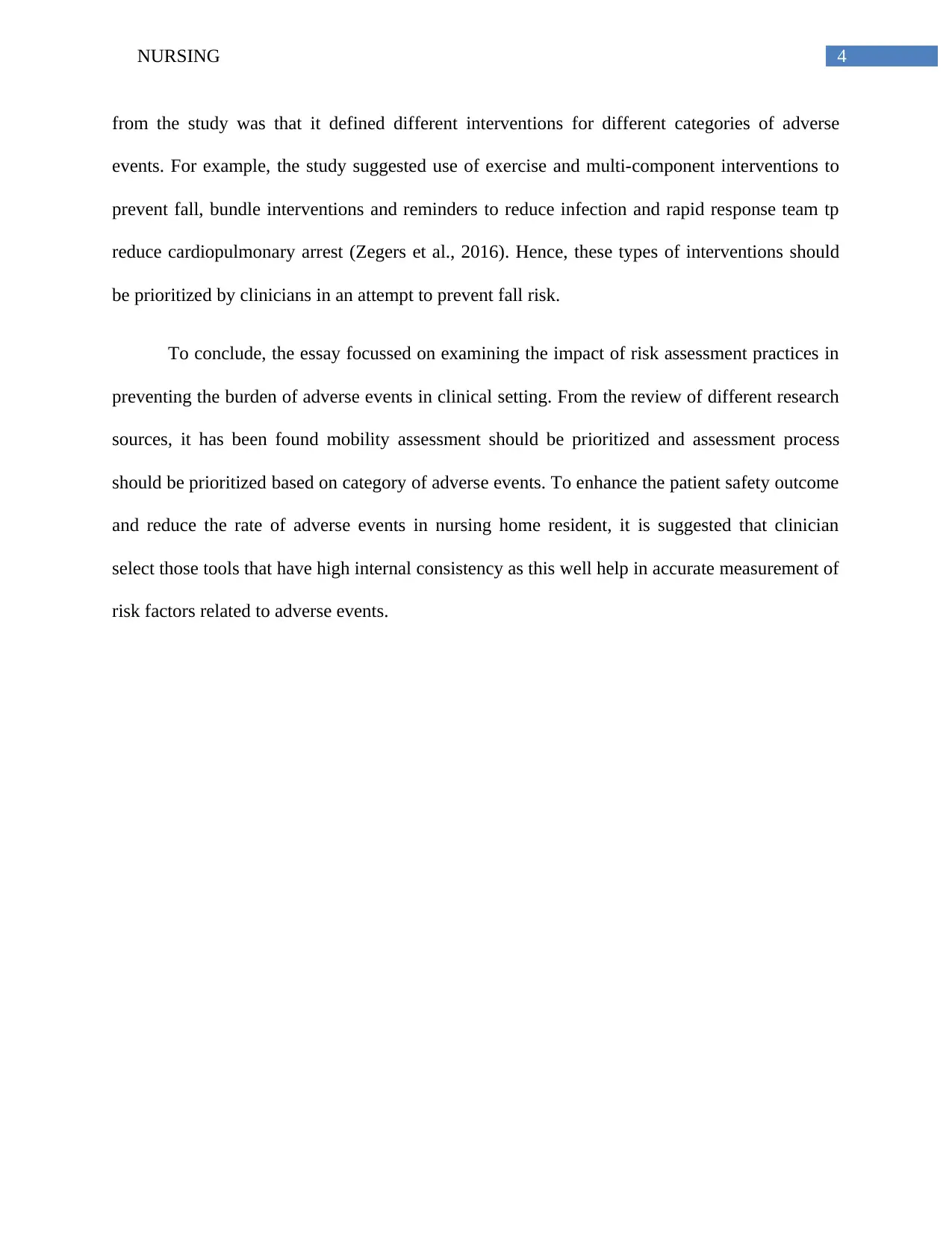
4NURSING
from the study was that it defined different interventions for different categories of adverse
events. For example, the study suggested use of exercise and multi-component interventions to
prevent fall, bundle interventions and reminders to reduce infection and rapid response team tp
reduce cardiopulmonary arrest (Zegers et al., 2016). Hence, these types of interventions should
be prioritized by clinicians in an attempt to prevent fall risk.
To conclude, the essay focussed on examining the impact of risk assessment practices in
preventing the burden of adverse events in clinical setting. From the review of different research
sources, it has been found mobility assessment should be prioritized and assessment process
should be prioritized based on category of adverse events. To enhance the patient safety outcome
and reduce the rate of adverse events in nursing home resident, it is suggested that clinician
select those tools that have high internal consistency as this well help in accurate measurement of
risk factors related to adverse events.
from the study was that it defined different interventions for different categories of adverse
events. For example, the study suggested use of exercise and multi-component interventions to
prevent fall, bundle interventions and reminders to reduce infection and rapid response team tp
reduce cardiopulmonary arrest (Zegers et al., 2016). Hence, these types of interventions should
be prioritized by clinicians in an attempt to prevent fall risk.
To conclude, the essay focussed on examining the impact of risk assessment practices in
preventing the burden of adverse events in clinical setting. From the review of different research
sources, it has been found mobility assessment should be prioritized and assessment process
should be prioritized based on category of adverse events. To enhance the patient safety outcome
and reduce the rate of adverse events in nursing home resident, it is suggested that clinician
select those tools that have high internal consistency as this well help in accurate measurement of
risk factors related to adverse events.
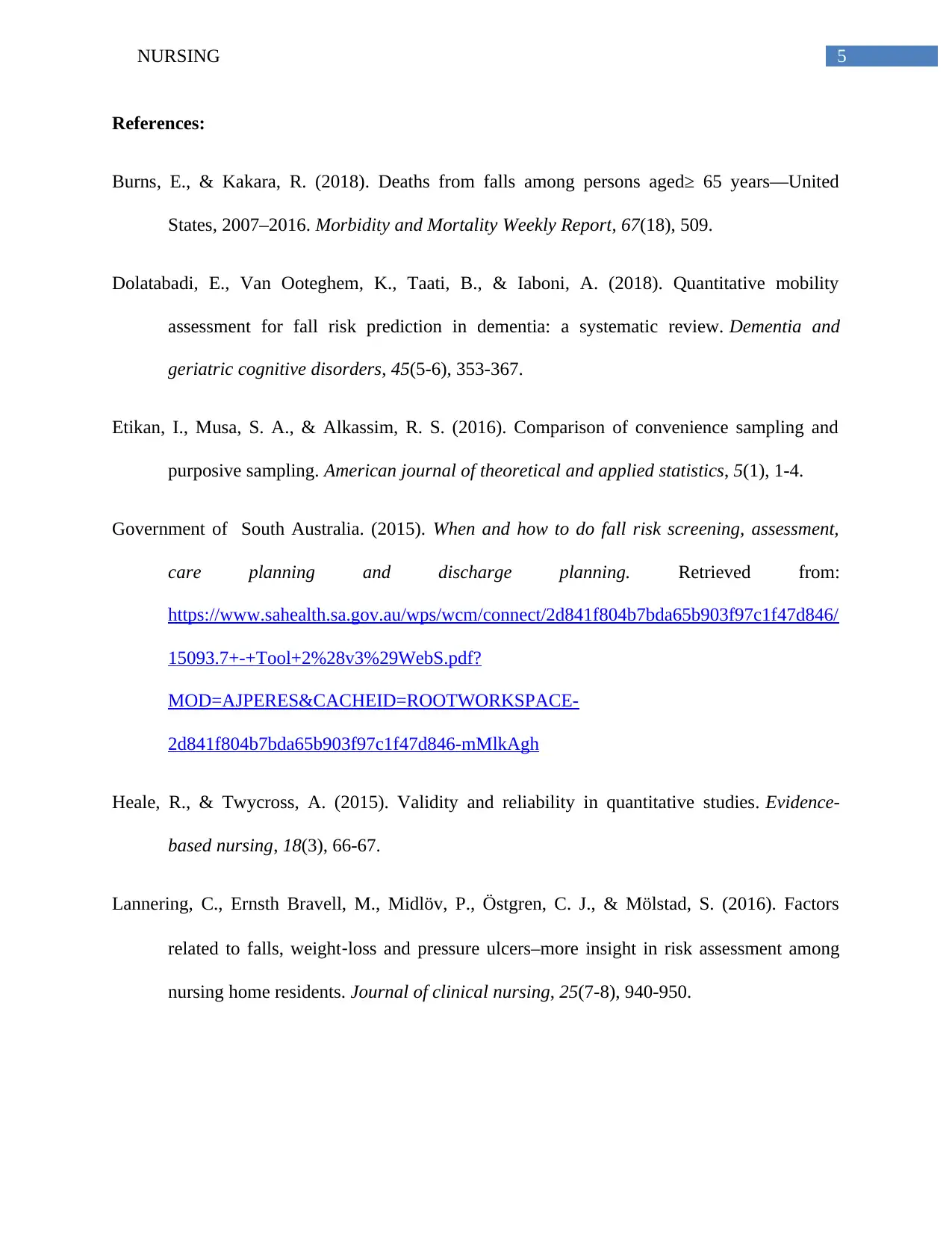
5NURSING
References:
Burns, E., & Kakara, R. (2018). Deaths from falls among persons aged≥ 65 years—United
States, 2007–2016. Morbidity and Mortality Weekly Report, 67(18), 509.
Dolatabadi, E., Van Ooteghem, K., Taati, B., & Iaboni, A. (2018). Quantitative mobility
assessment for fall risk prediction in dementia: a systematic review. Dementia and
geriatric cognitive disorders, 45(5-6), 353-367.
Etikan, I., Musa, S. A., & Alkassim, R. S. (2016). Comparison of convenience sampling and
purposive sampling. American journal of theoretical and applied statistics, 5(1), 1-4.
Government of South Australia. (2015). When and how to do fall risk screening, assessment,
care planning and discharge planning. Retrieved from:
https://www.sahealth.sa.gov.au/wps/wcm/connect/2d841f804b7bda65b903f97c1f47d846/
15093.7+-+Tool+2%28v3%29WebS.pdf?
MOD=AJPERES&CACHEID=ROOTWORKSPACE-
2d841f804b7bda65b903f97c1f47d846-mMlkAgh
Heale, R., & Twycross, A. (2015). Validity and reliability in quantitative studies. Evidence-
based nursing, 18(3), 66-67.
Lannering, C., Ernsth Bravell, M., Midlöv, P., Östgren, C. J., & Mölstad, S. (2016). Factors
related to falls, weight‐loss and pressure ulcers–more insight in risk assessment among
nursing home residents. Journal of clinical nursing, 25(7-8), 940-950.
References:
Burns, E., & Kakara, R. (2018). Deaths from falls among persons aged≥ 65 years—United
States, 2007–2016. Morbidity and Mortality Weekly Report, 67(18), 509.
Dolatabadi, E., Van Ooteghem, K., Taati, B., & Iaboni, A. (2018). Quantitative mobility
assessment for fall risk prediction in dementia: a systematic review. Dementia and
geriatric cognitive disorders, 45(5-6), 353-367.
Etikan, I., Musa, S. A., & Alkassim, R. S. (2016). Comparison of convenience sampling and
purposive sampling. American journal of theoretical and applied statistics, 5(1), 1-4.
Government of South Australia. (2015). When and how to do fall risk screening, assessment,
care planning and discharge planning. Retrieved from:
https://www.sahealth.sa.gov.au/wps/wcm/connect/2d841f804b7bda65b903f97c1f47d846/
15093.7+-+Tool+2%28v3%29WebS.pdf?
MOD=AJPERES&CACHEID=ROOTWORKSPACE-
2d841f804b7bda65b903f97c1f47d846-mMlkAgh
Heale, R., & Twycross, A. (2015). Validity and reliability in quantitative studies. Evidence-
based nursing, 18(3), 66-67.
Lannering, C., Ernsth Bravell, M., Midlöv, P., Östgren, C. J., & Mölstad, S. (2016). Factors
related to falls, weight‐loss and pressure ulcers–more insight in risk assessment among
nursing home residents. Journal of clinical nursing, 25(7-8), 940-950.
⊘ This is a preview!⊘
Do you want full access?
Subscribe today to unlock all pages.

Trusted by 1+ million students worldwide
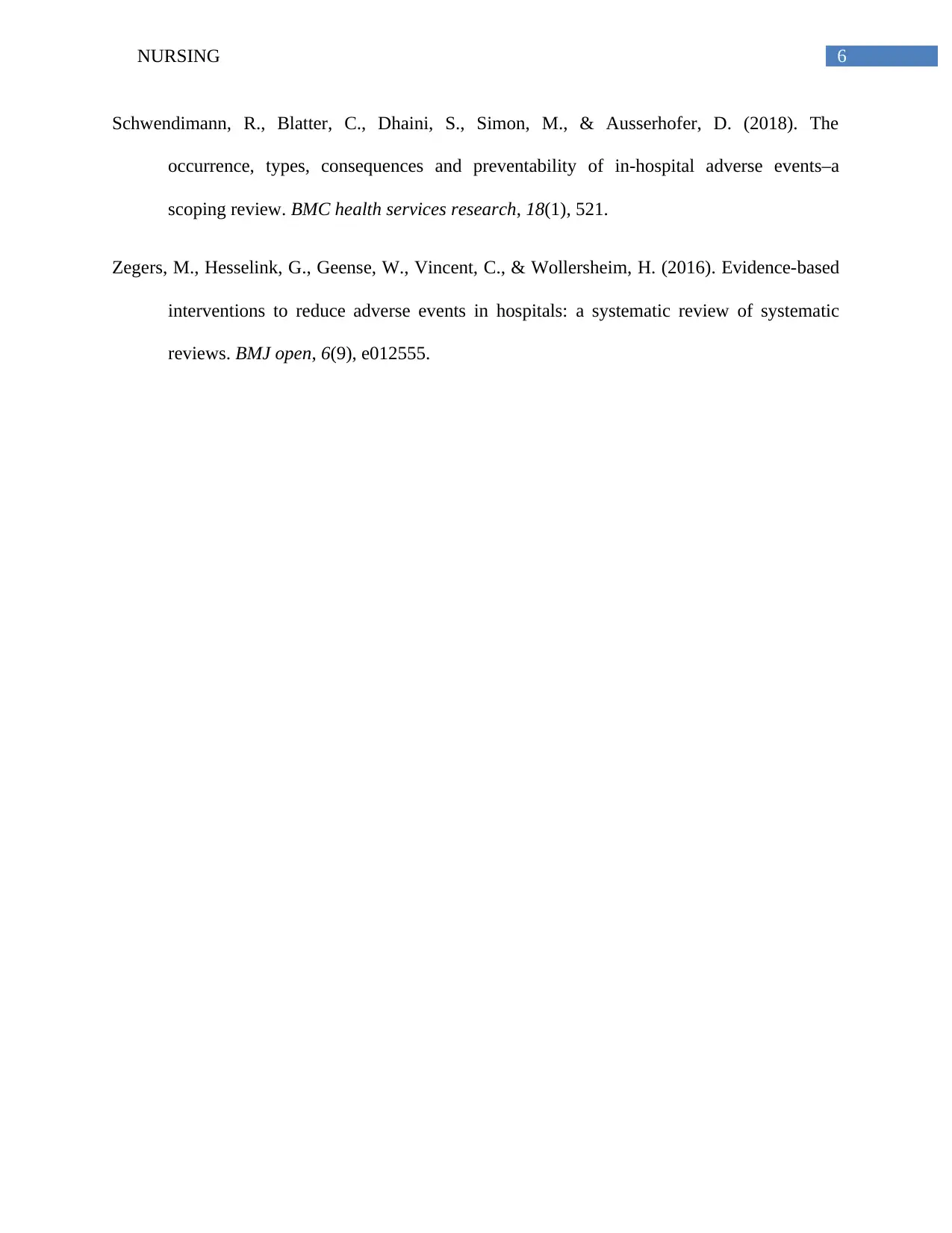
6NURSING
Schwendimann, R., Blatter, C., Dhaini, S., Simon, M., & Ausserhofer, D. (2018). The
occurrence, types, consequences and preventability of in-hospital adverse events–a
scoping review. BMC health services research, 18(1), 521.
Zegers, M., Hesselink, G., Geense, W., Vincent, C., & Wollersheim, H. (2016). Evidence-based
interventions to reduce adverse events in hospitals: a systematic review of systematic
reviews. BMJ open, 6(9), e012555.
Schwendimann, R., Blatter, C., Dhaini, S., Simon, M., & Ausserhofer, D. (2018). The
occurrence, types, consequences and preventability of in-hospital adverse events–a
scoping review. BMC health services research, 18(1), 521.
Zegers, M., Hesselink, G., Geense, W., Vincent, C., & Wollersheim, H. (2016). Evidence-based
interventions to reduce adverse events in hospitals: a systematic review of systematic
reviews. BMJ open, 6(9), e012555.
1 out of 7
Related Documents
Your All-in-One AI-Powered Toolkit for Academic Success.
+13062052269
info@desklib.com
Available 24*7 on WhatsApp / Email
![[object Object]](/_next/static/media/star-bottom.7253800d.svg)
Unlock your academic potential
Copyright © 2020–2025 A2Z Services. All Rights Reserved. Developed and managed by ZUCOL.





